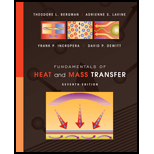
Concept explainers
Show that, for water at 1-atm pressure with
The physical significance of Jakob number for water and verify if this conclusion applies to other fluids and to show that Jakob number is unity for water.
Answer to Problem 10.1P
The Jakob number is less than unity for water and this applies to all the fluids which signify that Jakob number is always to be much less than unity.
Explanation of Solution
Given:
Pressure of water is
The temperature difference
Concept used:
Refer to table A-6 “Thermo physical properties of saturated water at pressure of 1.0133 bar” to obtain the value of heat of vaporization as
Write the expression for Jakob number of water.
Here,
Calculation:
Substitute
The value of Jakob number is
As the Jakob number is very less for water, it implies that the vapors absorbing latent heat is more than the vapors absorbing the sensible heat during the boiling phase change.
Check the value of Jakob number for other fluids like Ethylene glycol and mercury.
Refer to table A-5 “Thermo physical properties of saturated fluids at pressure of 1 atm” to obtain the value of heat of vaporization for ethylene glycol as
Substitute
Thus, the value of Jakob number for ethyl glycol is also than unity.
Refer to table A-5 “Thermo physical properties of saturated fluids at pressure of 1 atm” to obtain the value of heat of vaporization for mercury as
Substitute
Thus, the value of Jakob number for mercury is also than unity.
Conclusion:
Thus, the Jakob number is less than unity for water and this applies to all the fluids which signify that Jakob number is always to be much less than unity.
Want to see more full solutions like this?
Chapter 10 Solutions
Fundamentals of Heat and Mass Transfer
Additional Engineering Textbook Solutions
INTERNATIONAL EDITION---Engineering Mechanics: Statics, 14th edition (SI unit)
Mechanics of Materials (10th Edition)
Web Development and Design Foundations with HTML5 (8th Edition)
Degarmo's Materials And Processes In Manufacturing
Thinking Like an Engineer: An Active Learning Approach (4th Edition)
Starting Out with Programming Logic and Design (5th Edition) (What's New in Computer Science)
- (read image) (answer given)arrow_forward11-5. Compute all the dimensional changes for the steel bar when subjected to the loads shown. The proportional limit of the steel is 230 MPa. 265 kN 100 mm 600 kN 25 mm thickness X Z 600 kN 450 mm E=207×103 MPa; μ= 0.25 265 kNarrow_forwardT₁ F Rd = 0.2 m md = 2 kg T₂ Tz1 Rc = 0.4 m mc = 5 kg m = 3 kgarrow_forward
- 2. Find a basis of solutions by the Frobenius method. Try to identify the series as expansions of known functions. (x + 2)²y" + (x + 2)y' - y = 0 ; Hint: Let: z = x+2arrow_forward1. Find a power series solution in powers of x. y" - y' + x²y = 0arrow_forward3. Find a basis of solutions by the Frobenius method. Try to identify the series as expansions of known functions. 8x2y" +10xy' + (x 1)y = 0 -arrow_forward
- Hello I was going over the solution for this probem and I'm a bit confused on the last part. Can you please explain to me 1^4 was used for the Co of the tubular cross section? Thank you!arrow_forwardBlood (HD = 0.45 in large diameter tubes) is forced through hollow fiber tubes that are 20 µm in diameter.Equating the volumetric flowrate expressions from (1) assuming marginal zone theory and (2) using an apparentviscosity for the blood, estimate the marginal zone thickness at this diameter. The viscosity of plasma is 1.2 cParrow_forwardQ2: Find the shear load on bolt A for the connection shown in Figure 2. Dimensions are in mm Fig. 2 24 0-0 0-0 A 180kN (10 Markarrow_forward
- determine the direction and magnitude of angular velocity ω3 of link CD in the four-bar linkage using the relative velocity graphical methodarrow_forwardFour-bar linkage mechanism, AB=40mm, BC=60mm, CD=70mm, AD=80mm, =60°, w1=10rad/s. Determine the direction and magnitude of w3 using relative motion graphical method. A B 2 3 77777 477777arrow_forwardFour-bar linkage mechanism, AB=40mm, BC=60mm, CD=70mm, AD=80mm, =60°, w1=10rad/s. Determine the direction and magnitude of w3 using relative motion graphical method. A B 2 3 77777 477777arrow_forward
 Principles of Heat Transfer (Activate Learning wi...Mechanical EngineeringISBN:9781305387102Author:Kreith, Frank; Manglik, Raj M.Publisher:Cengage Learning
Principles of Heat Transfer (Activate Learning wi...Mechanical EngineeringISBN:9781305387102Author:Kreith, Frank; Manglik, Raj M.Publisher:Cengage Learning Refrigeration and Air Conditioning Technology (Mi...Mechanical EngineeringISBN:9781305578296Author:John Tomczyk, Eugene Silberstein, Bill Whitman, Bill JohnsonPublisher:Cengage Learning
Refrigeration and Air Conditioning Technology (Mi...Mechanical EngineeringISBN:9781305578296Author:John Tomczyk, Eugene Silberstein, Bill Whitman, Bill JohnsonPublisher:Cengage Learning

